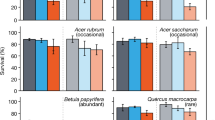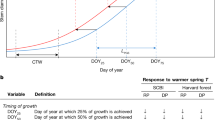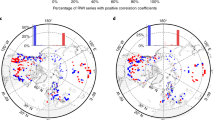Abstract
The extension of growing season at high northern latitudes seems increasingly clear from satellite observations of vegetation extent and duration1,2. This extension is also thought to explain the observed increase in amplitude of seasonal variations in atmospheric CO2 concentration. Increased plant respiration and photosynthesis both correlate well with increases in temperature this century and are therefore the most probable link between the vegetation and CO2 observations3. From these observations1,2, it has been suggested that increases in temperature have stimulated carbon uptake in high latitudes1,2 and for the boreal forest system as a whole4. Here we present multi-proxy tree-ring data (ring width, maximum late-wood density and carbon-isotope composition) from 20 productive stands of white spruce in the interior of Alaska. The tree-ring records show a strong and consistent relationship over the past 90 years and indicate that, in contrast with earlier predictions, radial growth has decreased with increasing temperature. Our data show that temperature-induced drought stress has disproportionately affected the most rapidly growing white spruce, suggesting that, under recent climate warming, drought may have been an important factor limiting carbon uptake in a large portion of the North American boreal forest. If this limitation in growth due to drought stress is sustained, the future capacity of northern latitudes to sequester carbon may be less than currently expected.
This is a preview of subscription content, access via your institution
Access options
Subscribe to this journal
Receive 51 print issues and online access
$199.00 per year
only $3.90 per issue
Buy this article
- Purchase on Springer Link
- Instant access to full article PDF
Prices may be subject to local taxes which are calculated during checkout





Similar content being viewed by others
References
Keeling, C. D., Chin, J. F. S. & Whorf, T. P. Increased activity of northern vegetation inferred from atmospheric CO2 measurements. Nature 382, 146–149 (1996).
Myneni, R. B., Keeling, C. D., Tucker, C. J., Asrar, G. & Nemani, R. R. Increased plant growth in the northern high latitudes from 1981–1991. Nature 386, 698–702 (1997).
Chapin, F. S. I., ZImov, S. A., Shaver, G. R. & Hobbie, S. E. CO2 fluctuation at high latitudes. Nature 383, 585–586 (1996).
Braswell, B. H., Schimel, D. S., Linder, E. & Moore III, B. The response of global terrestrial ecosystems to interannual temperature variability. Science 278, 870–872 (1997).
Chapman, W. L. & Walsh, J. E. Recent variations of sea ice and air temperature in high latitudes. Bull. Am. Meteorol. Soc. 74, 33–47 (1993).
Patric, J. H. & Black, P. E. Potential Evapotranspiration and Climate in Alaska by Thornthwaite's Classification. (USDA Forest Service Research Paper PNW-71, Juneau, Alaska, 1968).
Hogg, E. H. & Hurdle, P. A. The aspen parkland in western Canada: a dry-climate analogue for the future boreal forest? Wat. Air Soil Pollut. 82, 391–400 (1995).
Jacoby, G. C. & D'Arrigo, R. Reconstructed northern hemisphere annual temperature since 1671 based on high-latitude tree-ring data from North America. Clim. Change 14, 39–59 (1989).
Jacoby, G. C., D'Arrigo, R. D. & Juday, G. P. Tree-ring indicators of climatic change at northern latitudes. World Res. Rev. 11, 21–29 (1999).
Garfinkle, H. L. & Brubaker, L. B. Modern climate–tree-growth relationships and climatic reconstruction in sub-Arctic Alaska. Nature 286, 872–874 (1980).
Jacoby, G. C., D'Arrigo, R. D. & Davaajamts, T. Mongolian tree rings and 20th-Century warming. Science 273, 771–773 (1996).
Kozlowski, T. T. & Pallardy, S. G. Physiology of Woody Plants 1–411 (Academic Press, San Diego, California, 1997).
Livingston, N. J. & Spittlehouse, D. L. Carbon isotope fractionation in tree rings early and late wood in relation to intra-growing season water balance. Plant Cell Environ. 19, 768–774 (1996).
Jacoby, G. C., Ivanciu, I. S. & Ulan, L. D. A 263-year record of summer temperature for northern Quebec reconstructed from tree-ring data and evidence of a major climatic shift in the early 1800’s. Palaeogeogr. Palaeoclimatol. Palaeoecol. 64, 69–78 (1988).
D'Arrigo, R. D., Jacoby, G. C. & Free, R. M. Tree-ring width and maximum latewood density at the North American tree line: parameters of climate change. Can. J. Forest Res. 22, 1290–1296 (1992).
Denne, M. P. Effects of environmental change on wood production and wood structure in Picea sitchensis seedlings. Ann. Bot. 40, 1017–1028 (1976).
Conkey, L. E. Red spruce tree-ring widths and densities in eastern North America as indicators of past climate. Quat. Res. 26, 232–243 (1986).
Larsen, C. P. S. & MacDonald, G. M. Relations between tree-ring widths, climate, and annual area burned in the boreal forest of Alberta. Can. J. Forest Res. 25, 1746–1755 (1995).
Jacoby, G. C. & D'Arrigo, R. D. Tree ring width and density evidence of climatic and potential forest change in Alaska. Glob. Biogeochem. Cycles 9, 227–234 (1995).
Briffa, K. R. et al. Reduced sensitivity of recent tree-growth to temperature at high northern latitudes. Nature 391, 678–682 (1998).
Elliott-Fisk, D. L. in North American Terrestrial Vegetation (eds Barbour, M. C. & Billings, W. D.) 33–62 (Cambridge University Press, Cambridge, 1988).
Ruess, R. W., Van Cleve, K., Yarie, J. & Viereck, L. A. Comparative estimates of fine root production in successional taiga forests on the Alaskan interior. Can. J. Forest Res. 26, 1326–1336 (1996).
Van Cleve, K., Chapin III, F. S., Flanagan, P. W., Viereck, L. A. & Dyrness, C. T. Forest Ecosystems in the Alaskan Taiga: A Synthesis of Structure and Function 230 (Springer, New York, 1986).
Kicklighter, D. W. et al. A first-order analysis of the potential role of CO2 fertilization. Tellus B 51, 343–366 (1999).
Leavitt, S. W. & Long, A. Sampling strategy for stable carbon isotope analysis of tree-rings in pine. Nature 311, 145–147 (1984).
Briffa, K. R. & Osborn, T. J. Seeing the wood from the trees. Science 284, 926–927 (1999).
Cook, E. R. & Kairiukstis, L. A. Methods of Dendrochronology: Applications in the Environmental Sciences (Kluwer Academic, Dordrecht, The Netherlands, 1990).
Leavitt, S. W. & Danzer, S. R. Method for batch processing small wood samples to holocellulose for stable-carbon isotope analysis. Anal. Chem. 65, 87–89 (1992).
Francey, R. J. et al. A 1000-year high precision record of δ13C in atmospheric CO2. Tellus B 51, 170–193 (1999).
Thetford, R. D., D'Arrigo, R. D. & Jacoby, G. C. An image analysis system for determining densitometric and ring-width time series. Can. J. Forest Res. 21, 1544–1548 (1991).
Acknowledgements
This work was carried out with the financial support of the McIntire–Stennis Cooperative Forestry Research Program, the US NSF Long-Term Ecological Research (LTER) Program and Paleoclimates from Arctic Lakes and Estuaries (PALE) Program, the University of Alaska's Natural Resource Fund, International Arctic Research Centre (IARC), and the Centre for Global Change and Arctic System Research. We thank T. Chapin for enthusiastic support and helpful review of this manuscript. We also thank G. Jacoby for use of his laboratory and equipment for density analyses, and A. Krumhardt for field and laboratory assistance.
Author information
Authors and Affiliations
Corresponding author
Rights and permissions
About this article
Cite this article
Barber, V., Juday, G. & Finney, B. Reduced growth of Alaskan white spruce in the twentieth century from temperature-induced drought stress. Nature 405, 668–673 (2000). https://doi.org/10.1038/35015049
Received:
Accepted:
Issue Date:
DOI: https://doi.org/10.1038/35015049
This article is cited by
-
Rising utilization of stable isotopes in tree rings for climate change and forest ecology
Journal of Forestry Research (2024)
-
Picea pungens exhibits greatest tolerance to short-time thermal stress compared to Picea abies, and Picea omorika
New Forests (2023)
-
Impacts of climate change and anthropogenic activities on the normalized difference vegetation index of desertified areas in northern China
Journal of Geographical Sciences (2023)
-
The phenotypic and genetic effects of drought-induced stress on apical growth, ring width, wood density and biomass in white spruce seedlings
New Forests (2023)
-
Effects of altitude and slope on the climate–radial growth relationships of Larix olgensis A. Henry in the southern Lesser Khingan Mountains, Northeast China
Ecological Processes (2022)
Comments
By submitting a comment you agree to abide by our Terms and Community Guidelines. If you find something abusive or that does not comply with our terms or guidelines please flag it as inappropriate.



